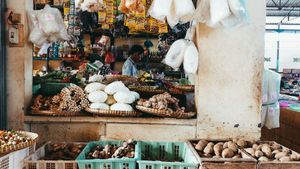Rice prices that continue to climb provoke concerns. In addition to rice traders, the most affected by the insane increase in rice prices is the household sector.
The price of large premium retailers even reached Rp. 17,000 per kg. This figure is up almost Rp. 5,000 compared to not December 2022. Suddenly the increase in rice prices has become a topic of conversation among the public. Understandably, rice is a staple food for most people in Indonesia.
The increase in the price of unhulled rice, both GKP (Penen Dry Rice) and GKG (Gried Giling Rice) is said to be one of the causes of the recent skyrocketing increase in rice prices.
Food observer from the Indonesian Political Economy Association (AEPI), Khudori said, apart from soaring grain prices, the increase in rice prices was due to limited supply. This happened because the harvest season from February to May had passed.
Khudori is worried that the summer, which is predicted to be longer than usual, will also play a role in making prices even more creepy. The reason is, the Meteorology, Climatology and Geophysics Agency predicts this summer this year could take longer due to the impact of El Nino.
"Starting October, we will start entering the famine season which means production is even smaller. This will take place, if the weather is normal, until January next year. But because there is El Nino it could increase for a month or two. This means that the famine season becomes longer. This potential continues to raise the price of grain and rice higher. How high? It depends on the extent of market intervention carried out by the government," said Khudori to VOI.
The phenomenon of El Nino, which has become the headline in various national media in the last few months, has also had a major impact on the agricultural sector. A number of parties estimate that rice production will decrease by 1.5 million tons of GKG. In fact, some estimate that rice production will decrease by five percent.
Khudori hopes that the government, both central and regional, will move quickly to make various efforts to suppress the increase in short-term rice prices. Efforts that can be made include accelerating planting in existing areas of water, helping pumps, providing assistance with gemated-aged seeds, and preparing 500 thousand hectares of new planting.
"This must be well guarded. So that if El Nino really has a tough impact, there will still be compensated production. But all of this will still be reaped in November or December. The results cannot be estimated as to what," Khudori added.
Importing rice for now can be a short-term solution to put the brakes on price increases so that it doesn't increase. When the availability of rice in the market is safe, the price increase can be reduced. In addition, the social assistance program (bansos) from the government can also make rice prices relatively stable.
"Opsi ensures that the two million tons of import quota to Bulog is realized. If that can be done, hopefully the supply will be more adequate. The government's intervention in the form of rice social assistance distributed from September to November can certainly put the brakes on price increases so as not to be higher. Referring to the rice social assistance in March-May, it turns out that rice prices are relatively stable. Rising but thin. Rice inflation is also low," said Khudori explaining.
Rice stock constraints have actually been discussed since a few months ago, along with the BMKG's warning of the El Nino phenomenon which could trigger a long drought. At that time, the food diversification program was discussed again. Food diversification is said to be one solution to overcome the shortage of rice availability.
Food diversification is an effort to encourage the public to vary the staple foods consumed so that they are not focused on just one type. The purpose of food diversification is to explore and increase the provision of various food commodities so that there is a diversity of people's food consumption.
Unfortunately, the food diversification program is also far from successful. In fact, according to Khudori, if the food diversification program is successful, it will help reduce demand for rice.
Food diversification efforts are far from successful. The steps taken by the government, both central and regional, are still partial. If diversification is successful, the pressure on demand for rice will decrease," he said.
Uli Arta Siagian as Manager of National WALHI Forest and Gardens Campaign, explained several factors that caused the failure to diversify food. One of them is by focusing only on one type of food, for example rice.
"Food diversification can be done to anticipate crop failure, but it must pay attention to two things, namely the traditional way of the community and the types of local plants planted. Because it's useless if the actors are handed over to corporations or the types are common without seeing what food is being developed," said Uli Arta to VOI some time ago.
"Food diversification is actually not new. The word diversification arises from the academy space, but actually in many areas, in their villages they do the same thing. They have other types of food grown on their own land, they just have to take the food they grow, such as vegetables. That's what they do or what we call food sovereignty, "said Uli Arta asserted.
SEE ALSO:
The English, Chinese, Japanese, Arabic, and French versions are automatically generated by the AI. So there may still be inaccuracies in translating, please always see Indonesian as our main language. (system supported by DigitalSiber.id)














